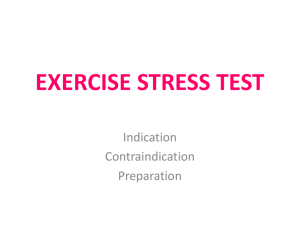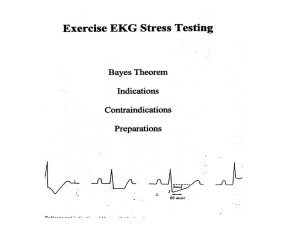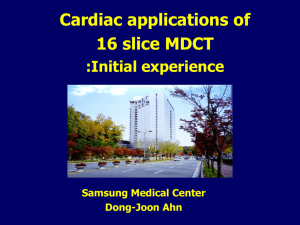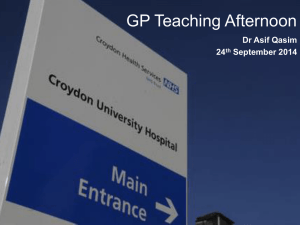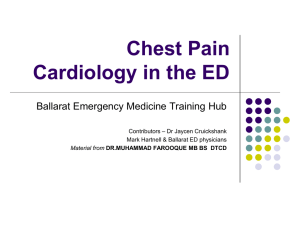Cardiac stress testing
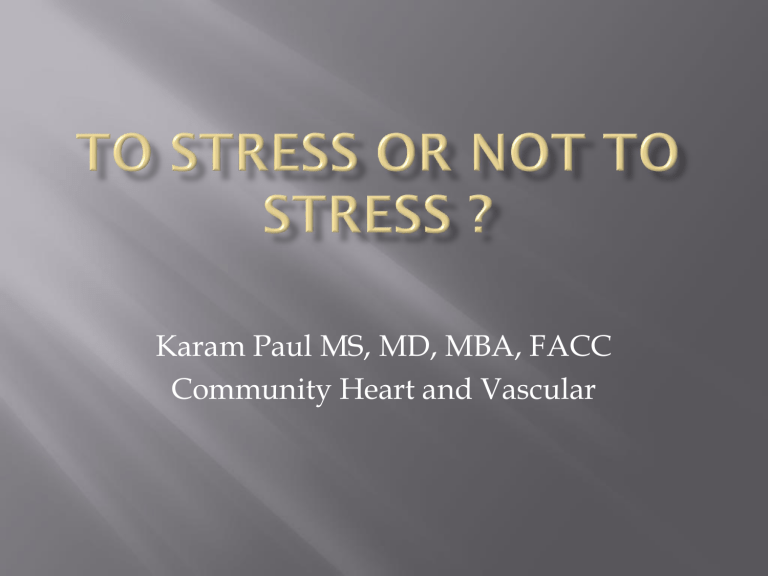
Karam Paul MS, MD, MBA, FACC
Community Heart and Vascular
►Know why to undertake a stress test
►Know who should have one
►Know how it is performed
►Understand the limitations
►Understand which to choose
►Know what to do with the result
Why do a stress test?
►Elicit abnormalities not present at rest
►Estimate functional capacity
►Estimate prognosis
►Likelihood of coronary artery disease
►Extent of coronary artery disease
►Effect of treatment
Who should have one?
►Bayes’ Theorem
►Consider the ‘pre-test risk’
►Sensitivity & specificity of the test
►Post-test probability of CAD
►Diagnostic power of EST is maximal when the pre-test probability is intermediate.
►Pre-existing coronary artery disease
►Diabetes
►Hypertension
►Smoking history
►Family history
►Renal disease
Pre-existing coronary artery disease
►Diabetes
►Hypertension
►Hyperlipidemia
►Smoking history
►Family history
►Renal disease
►Pre-existing coronary artery disease
►Diabetes
►Hypertension
►Hyperlipidemia
►Smoking history
►Family history
►Renal disease
How is it done?
►ECG
►Exercise capacity (METS – metabolic equivalent)
►Symptoms
►Blood pressure
►Heart rate response & recovery
1mm planar ST depression
3 consecutive beats
► The normal and rapid upsloping ST segment responses are normal responses to exercise.
► Minor ST depression can occur occasionally at submaximal workloads in patients with coronary disease.
► The slow upsloping ST segment pattern often demonstrates an ischemic response in patients with known coronary disease or those with a high pretest clinical risk of coronary disease.
► Downsloping ST segment depression represents a severe ischemic response.
► ST segment elevation in an infarct territory
(Q wave lead) indicates a severe wall motion abnormality and, in most cases, is not considered an ischemic response.
(From Chaitman BR: Exercise electrocardiographic stress
testing. In Beller GA [ed]: Chronic Ischemic Heart Disease. In
Braunwald E [series ed]: Atlas of Heart Diseases. Vol 5. Chronic
Ischemic Heart Disease. Philadelphia, Current Medicine, 1995, pp 2.1-2.30
► Influenced by:
Body position
Respiration
Hyperventilation
Drug Rx
Myocardial ischemia
Necrosis
► Pseudonormalisation:
Usually non-diagnostic
Consider ancillary imaging
►Peak HR > 85% of maximal predicted for age
►HR recovery >12 bpm (erect)
►HR recovery >18 bpm (supine)
Parameters associated with adverse prognosis or multivessel disease
► Duration of symptom-limiting exercise <5 METs
► Failure to increase sBP ≥120mmHg, or a sustained decreased ≥
10mmHg, or below rest levels, during progressive exercise
► ST segment depression ≥2mm, downsloping ST segment, starting at
<5 METs, involving ≥5 leads, persisting ≥5 min into recovery
► Exercise-induced ST segment elevation (aVR excluded)
► Angina pectoris at low exercise workloads
► Reproducible sustained (>30 sec) or symptomatic ventricular tachycardia
► Non-diagnostic ECG changes
► False positives/false negatives
► Women – false positives
► Elderly – more sensitive/less specific
► Diabetics – autonomic dysfunction
► Hypertension
► Inability to exercise
► Drugs – digoxin; anti-anginals
► Anemia
► Cardiomyopathy
► Digoxin
► Glucose load
► Hyperventilation
► Hypokalemia
► Intraventricular conduction disturbance
► Mitral valve prolapse
► Pre-excitation syndrome
► Severe aortic stenosis
► Severe hypertension
► Severe hypoxia
► Severe volume overload (aortic or mitral regurgitation)
► Sudden excessive exercise
► Supraventricular tachycardia's
Sensitivity 68%
Specificity 77%
Echocardiography
Radionuclide imaging
Compares pre & post:
Regional contractility
Overall systolic function
Volumes
Pressure gradients
Filling pressures
Pulmonary pressures
Valvular function
Factors which effect image quality:
Body habitus
Lung disease
Breast implants
►54 year old bank project manager
►Exertional chest pain & dyspnea
►Ex-smoker
►TC = 6.7mmol/L
►Stress ECG – 2mm ST segment depression in 5 leads
►62 year old female
►Chest pain & dyspnea
►Treadmill exercise test – non-diagnostic sub-maximal
Hypertension
No ECG changes
►Exercised 7½ minutes (9.4
METS)
►No chest pain
►ECG changes
►24 year old female engineer
►Exertional dyspnea
►Palpitations
Inducible dyspnea
►ECG partial right bundle branch block no ischemic changes
►43 year old male - airline catering
►Chest pain
►Dyspnea
►Inducible dyspnea
►Non-specific T wave changes
►No ST segment shift
►Global deterioration in left ventricular function
►Radio-tracer injection
►Isotopes:
Thallium-201
Technetium 99m (sestamibi)
►Myocardial uptake
►Photon emission captured by gamma camera
►Rest & redistribution phases
►Pharmacologic protocols available
►Digital presentation
Reversible inferior wall defect
Milder reversible inferior wall defect
►Time-consuming
►Artifacts
►Balanced ischemia
►Radiation
Normal apical thinning.
A. Breast attenuation B. Anterior ischemia
►Risk of iatrogenic malignancy
►Linear no-threshold model
►Consider: age gender background
Einstein, A. J. et al. Circulation 2007;116:1290-1305
Useful for:
►Patients unable to exercise
►ECG uninterpretable
►Unsuitable for DSE
And….
►No radiation
But…
►Not currently available
►45 year old diabetic man
►Anterior chest discomfort with exertion
►Exercised for 2 mins 30 secs (4.6 METs)
►95% maximal predicted heart rate
►Mild chest pain
►BP increased from baseline to
180/80mmHg
►1mm ST depression in leads II, III, aVF,
V4-6
1. Pre-test risk is intermediate
2. Post-test probability for cardiac events is high
3. The ECG changes are non-diagnostic
4. The ECG changes are false-positive in the setting of hypertension
5. Chest pain is not a useful symptom in diabetics
1. Pre-test risk is intermediate
2 . Post-test probability for cardiac events is high
3. The ECG changes are non-diagnostic
4. The ECG changes are false-positive in the setting of hypertension
5. Chest pain is not a useful symptom in diabetics
Parameters associated with adverse prognosis or multivessel disease
► Duration of symptom-limiting exercise <5 METs
► Failure to increase sBP ≥120mmHg, or a sustained decreased ≥ 10mmHg, or below rest levels, during progressive exercise
► ST segment depression ≥2mm, downsloping ST segment, starting at <5 METs, involving ≥5 leads, persisting ≥5 min into recovery
► Exercise-induced ST segment elevation (aVR excluded)
► Angina pectoris at low exercise workloads
► Reproducible sustained (>30 sec) or symptomatic ventricular tachycardia
►Pre-test risk of disease
►Sensitivity & specificity of the test
►Value of supplementary data
►AND JUST ONE MORE TIP……..
So….which one to choose?
►Remember Bayes’ theorem
►Consider the pre-test risk
►Be aware of the sensitivity & specificity of the test
►Apply the post test probability
►Correlates with presence & extent of CAD
►Strong negative predictive value
►Cannot predict functional significance
►Higher scores can predict events
►Recommended for asymptomatic with intermediate risk
Calcification of the left anterior descending coronary artery
( large arrow ) and left circumflex coronary artery
(small arrow).
Score description RR
0 nil
1 – 99 mild 1.9
100 – 399 moderate 4.3
400 – 999 severe 7.2
>1000 extensive 10.8
► Indicated – asymptomatic with intermediate risk
► Not for low risk/population screening
► High risk – use current guidelines
► Do not reduce Rx if intermediate risk & ‘0’ score
►2-dimensional & 3dimensional reconstructions
►Relies on slow, regular heart rate
►High negative predictive value (‘rule out’ ability)
►Lower positive predictive value (over-estimation tendency)
►Grading of stenosis limited
►Does not evaluate functional significance
►Radiation exposure
►Role not yet clearly defined
►Potential for those with intermediate likelihood of disease:
Where stress testing not possible
Stress test equivocal/uninterpretable
Acute chest pain/no ECG changes/normal enzymes
►Role in anomalous anatomy
